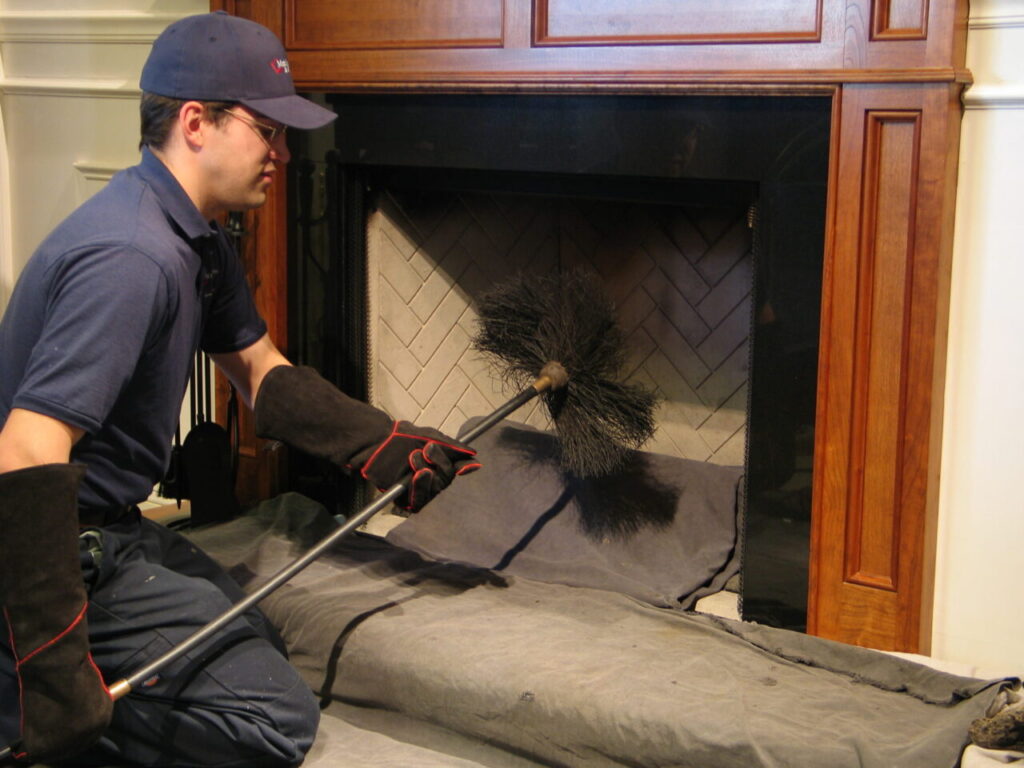Nothing soothes the soul and warms the heart more in the wintertime than the flickering ambiance of a fire. For many, it’s not just a cozy way to spend an afternoon — it’s an important source of heat.
Whether your fire sets the scene or keeps your family warm, taking a few steps to ensure your fireplace and chimney are up to the task is critical. Seasonal maintenance ensures your fire burns more efficiently — saving you money — while also ensuring it burns more safely — potentially saving your life.
How does a fireplace work?
The first step to keeping the fire burning safely at home is understanding how your fireplace and chimney work. Wood-burning and gas-powered fireplaces contain the fuel and the fire, while the chimney moves harmful byproducts of the fire, such as smoke and particulates, out of your home.
A poorly maintained chimney cannot do its job, which could lead to a dangerous situation. In addition to smoke, burning fuel produces carbon monoxide, a deadly gas. If your fireplace and chimney aren’t functioning properly, carbon monoxide can leak into your home.
Prioritize an annual cleaning and inspection
Before you light the first fire of the season, call your local chimney sweep for an annual cleaning and inspection. Creosote is a natural deposit that builds up inside your chimney as your fire burns. It’s highly flammable and can pose a serious fire hazard if sparks land in the creosote and ignite a chimney fire. These burn exceptionally hot and can quickly get out of control. Wood fires produce the most creosote, but fires in pellet stoves also produce creosote.
A chimney sweep will safely remove built-up creosote and conduct a safety inspection of your chimney. A camera lowered into the chimney can identify structural problems or obstructions that can lead to dangerous conditions.
Make repairs
If an inspection reveals problems, don’t ignore them. Make repairs in a timely manner to prevent more extensive problems that can affect the value of your home if you decide to sell.
Repairs might include:
- – Replacing chimney flashing to prevent leaks
- – Replacing a damaged or missing chimney cap
- – Cleaning the blower on your gas fireplace
- – Fixing damage to the firebox
- – Replacing a worn or damaged chimney liner
If you’re listing your home and you don’t want to make large, expensive repairs to your fireplace or chimney, you could sell as-is to a company that buys houses for cash. However, these companies deduct money for repairs, so you’ll end up with less than market value.
Use the correct fuel
Burning the correct fuel in your fireplace means safer, more efficient fires. Using wood from your annual shrub and tree pruning may be tempting, but this wood is green and will burn inefficiently. It may also cause more creosote buildup than dry, seasoned wood that produces the best fires.
If you use a gas fireplace, check the supply lines and connections to make sure everything is working properly. You can also request a technician by calling your local gas supplier if you need help.
Finally, only use your fireplace to burn the fuel it is designed for. An indoor fire is not the place to burn trash or large amounts of paper.
Operate your fireplace safely
Safe fireplace operation means tending the fire and ensuring it’s fully extinguished when you leave home or go to sleep. This can be challenging for families who rely on their wood-burning or pellet stove for heat. Check with your fireplace’s manufacturer for recommendations on how to safely maintain a fire.
If you have an open hearth, invest in a metal screen to keep embers from snapping out of the fireplace and onto the floor. Keep the area in front of the fireplace clear of flammable materials, and keep a watchful eye on small children when a fire is lit.
Invest in carbon monoxide detectors
Carbon monoxide detectors should be located at least 15 feet from the fireplace and mounted low on the wall. Carbon monoxide is a heavy, odorless gas, so early detection is critical. If your chimney is properly maintained and vented, the small amount emitted from a fireplace is not a problem, but a detector can alert you if something malfunctions. It could save your life.
Have an emergency plan
Although a fire extinguisher should be present in every home, it’s even more critical that they are accessible in homes with fireplaces. Learn how to use them, and teach older children to use them as well.
More importantly, develop an emergency plan with your family. Identify multiple exits from the house, including windows, and designate a safe meeting place if you get separated.
Enjoy the warmth of a glowing fire
Maintaining your fireplace and chimney is a small price to pay for the warmth of a roaring fire on a cold winter’s evening. Taking these simple steps will allow your family to safely enjoy a fire all winter long.
15 Must-Have Winter Home Maintenance Tools and Supplies


